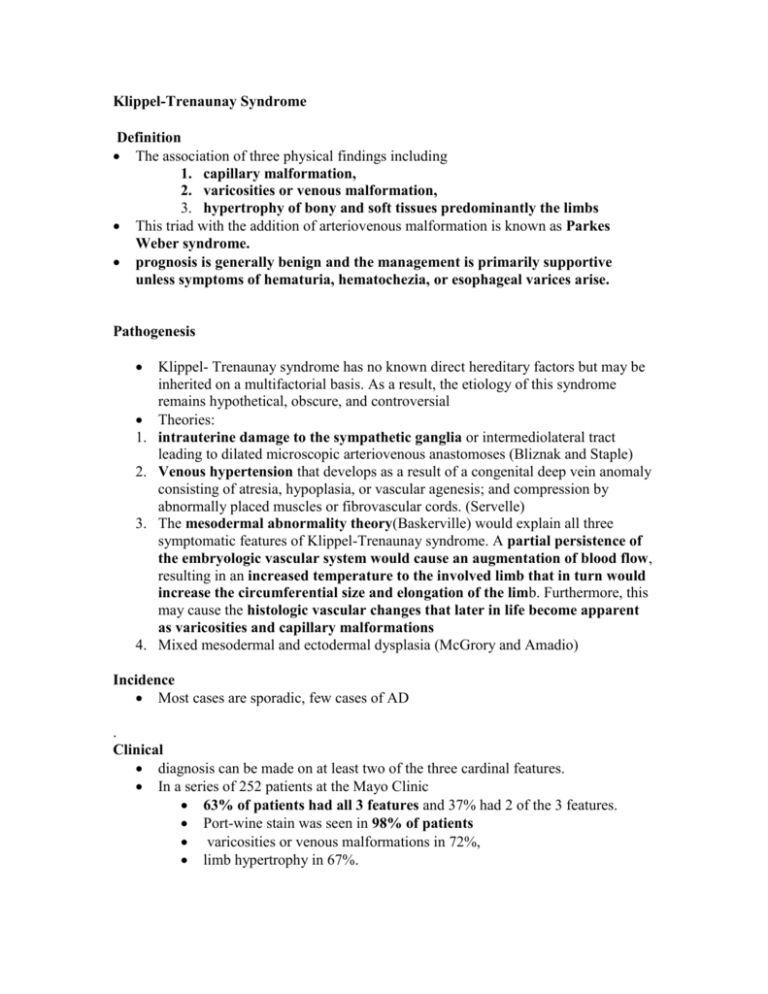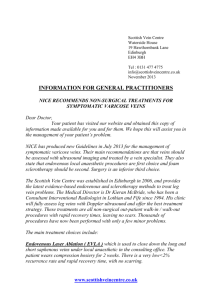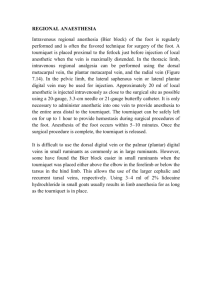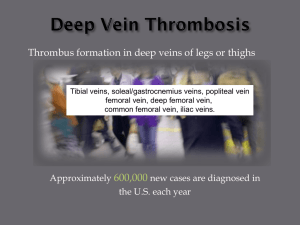Klippel Trenaunay
advertisement

Klippel-Trenaunay Syndrome Definition The association of three physical findings including 1. capillary malformation, 2. varicosities or venous malformation, 3. hypertrophy of bony and soft tissues predominantly the limbs This triad with the addition of arteriovenous malformation is known as Parkes Weber syndrome. prognosis is generally benign and the management is primarily supportive unless symptoms of hematuria, hematochezia, or esophageal varices arise. Pathogenesis 1. 2. 3. 4. Klippel- Trenaunay syndrome has no known direct hereditary factors but may be inherited on a multifactorial basis. As a result, the etiology of this syndrome remains hypothetical, obscure, and controversial Theories: intrauterine damage to the sympathetic ganglia or intermediolateral tract leading to dilated microscopic arteriovenous anastomoses (Bliznak and Staple) Venous hypertension that develops as a result of a congenital deep vein anomaly consisting of atresia, hypoplasia, or vascular agenesis; and compression by abnormally placed muscles or fibrovascular cords. (Servelle) The mesodermal abnormality theory(Baskerville) would explain all three symptomatic features of Klippel-Trenaunay syndrome. A partial persistence of the embryologic vascular system would cause an augmentation of blood flow, resulting in an increased temperature to the involved limb that in turn would increase the circumferential size and elongation of the limb. Furthermore, this may cause the histologic vascular changes that later in life become apparent as varicosities and capillary malformations Mixed mesodermal and ectodermal dysplasia (McGrory and Amadio) Incidence Most cases are sporadic, few cases of AD . Clinical diagnosis can be made on at least two of the three cardinal features. In a series of 252 patients at the Mayo Clinic 63% of patients had all 3 features and 37% had 2 of the 3 features. Port-wine stain was seen in 98% of patients varicosities or venous malformations in 72%, limb hypertrophy in 67%. generally affects a single extremity, although cases of multiple affected limbs have been reported. The most common limbs involved are the lower extremities (88 to 95%), followed by the upper extremities (5%). Unilateral involvement occurs in 85% of cases. Upper and lower extremity combined involvement occurs in 15 percent. Very rarely, four extremity involvement has been reported. Capillary hemangioma or port-wine stain usually presents first. has a distinct, linear border that respects the midline. Hemangioma is often noted on the lateral aspect of the limb. Skin changes usually occur on the same side as the affected limb (85 %); however, it is not uncommon to have additional capillary malformations occurring on the contralateral limb or in another area of the body such as the trunk or head and neck. Although the capillary malformation is usually confined to the skin may see involvement of subcutaneous tissues, muscles, and abdominal and thoracic cavities. Some patients may undergo depigmentation or “fading” of the malformation as a result of capillary thromboses, whereas others progress to additional skin changes such as atrophy, eczema, verrucae, hyperhidrosis, bleeding, and infections. Although complete disappearance of the capillary malformation does not occur, aging may result in significant “fading” of the malformation. Puberty and pregnancy may exacerbate the capillary malformation. Varicose veins Abnormalities described are hypoplasia, agenesis, valvular incompetence, and aneurysmal dilatation of the deep venous system Without supportive care, these varicosities may be painful, tender, and worsen symptomatically with increasing age. At times, ulcerations develop that may result in a superficial thrombophlebitis or cellulitis Patches of lipodermatosclerosis may also occur The vein of Serville (70%) is a large, lateral, superficial vein sometimes seen at birth. This vein begins in the foot or the lower leg and travels proximally until it enters the thigh or the gluteal area (lumbar to foot pattern) In the majority (33 percent) of cases, the lateral vein will extend to the full length of the leg, terminating into the internal iliac system through the gluteal veins. In the rest of the patients, the lateral vein is variable in distance, terminating in decreasing frequency in the profundus femoris vein, superficial femoral vein, popliteal vein, and external iliac vein. Varicosities may be extensive, though they often spare the saphenous distribution Surgical exploration has demonstrated atresia and agenesis of deep veins, compression due to fibrous bands, aberrant arteries, abnormal muscles, or venous sheaths. Bony and soft tissue hypertrophy secondary to increased length (bony involvement) and/or increased girth (soft tissue involvement) usually progresses during the first years of life. A greater degree of hypertrophy may be seen in patients with coexisting arteriovenous malformation discrepancy in limb length is secondary to long-bone growth (i.e., femur and/or tibia). The increasing limb girth is primarily caused by soft-tissue hypertrophy and, to a lesser extent, muscular hypertrophy accompanied by increasing vascular tissue and skin thickness. Arteriovenous fistulas, (Parkes-Weber syndrome) Addition of large hemodynamically significant AVMs. Small insignificant AVMs fall into the definition of KTS. rarely found in the affected extremity If present, they can occasionally be palpated as a pulsatile mass, thrill, or bruit on physical examination. Hyperthermia and a positive Branham sign (bradycardia with the application of compression on an artery proximal to the malformation) are also indicators of an arteriovenous malformation. Associated Abnormality The major associated malformations seen in Klippel-Trenaunay syndrome are generally divided into vascular, skeletal, cutaneous, and lymphatic 1. skeletal findings: the most commonly (29 percent) associated abnormalities found were dislocation of the hip and syndactyly. 2. vascular: hematochezia (GI bleed) and hematuria, and esophageal variceal bleeding, although rare, but very serious findings. Vaginal and vulvar hemorrhaging are not as serious, but may be problematic. Hematochezia is considered the most common form of bleeding in Klippel-Trenaunay patients, and its pathophysiologic characteristics are intriguing - related to the connection between these veins and the internal / ext iliac system. When these get overloaded back pressure into the rectal veins leads to varicosities and bleeding. 3. Lymphatic abnormalities are common and can be extremely disabling. The lymphatic anomalies most commonly observed are lymphatic aplasia, hypoplasia, and reduction of both lymphatic trunks and nodes. The resulting signs appear as either lymphedema or cutaneous lymphatic vesicles that occur secondary to backflow from an obstructed or congested deep lymphatic system. DIAGNOSIS AND TREATMENT Management and treatment of this disease is generally supportive unless the patient becomes overly symptomatic or disabled. Although the majority of Klippel- Trenaunay patients will complain of physical disturbances, approximately 25% will approach the physician for cosmetic reasons. Capillary Malformation In general, capillary malformations are left alone unless they become progressively symptomatic. Skin breakdown and ulcerations with subsequent bleeding may lead to surgical excision of the overlying skin. Although this may be a direct approach to the malformation, it is important to note that the affected skin heals rather poorly Hence, any resection of the malformation should be performed with caution in trying to minimizing excessive scar formation and the likelihood of wound-healing complications. Light-colored malformations can be successfully camouflaged with appropriate cosmetic products, whereas more intense and dark colored malformations require a more aggressive approach. pulse dye lasers have made an impact in the treatment of malformations. The new pulse dye lasers have been adjusted with a longer wavelength, which has provided a greater depth of dermal penetration, without compromising vascular specificity. Thus, the heat produced by the laser is targeted toward vascular structures and not to adjacent normal elements. Managing malformations by means of this method requires a half dozen or more treatments with 6-week intervals. Malformations of the bladder in patients with Klippel- Trenaunay syndrome resulting in hematuria have also been successfully treated with a neodymium:yttriumaluminum-garnet laser, resulting in excellent tissue coagulation. Varicosities Ligation and stripping of varicosities is rarely recommended and should be performed only after careful invasive radiologic review of the venous outflow of the extremities. Generally, varicosities are managed supportively with intermittent rest, elevation, reassurance, and continued reinforcement in wearing graduated compressive stockings. Thrombophlebitis or cellulitis should be treated nonoperatively with analgesics and antibiotics, respectively. Surgery When conservative measures become realistically resistant, both aggressive and invasive forms of treatment may be used Before surgical treatment of any varicosities, radiographic examination is required. The most effective imaging techniques used are venography and magnetic resonance imaging. Duplex venograms should be obtained in all cases before surgical interventions to visualize the entire venous anatomy for venous anomalies, valvular incompetence, and persistent embryologic veins. Large varicosities should never be ligated or stripped, especially when the deep venous system is found to be either partially or completely atretic. The suprapubic veins should never be resected because they serve as a substitute channel for the atretic iliac vein. Most surgical procedures performed with the intention of improving varicosities are temporary and short-lived and frequently worsen the condition. percutaneous injection of sclerosing agents Agents: sodium tetradecyl sulfate and absolute alcohol. This method promotes irritation of the endothelium, obliterating the vessel lumen and resulting in fibrosis. Sclerotherapy may be facilitated by color-duplex imaging Because some veins recanalize (18 percent),31 multiple injections (up to 30 in some cases) may be required at appropriate intervals (4 to 6 weeks), allowing the inflammatory responses to subside. Eventually, with an appropriate sclerosing protocol, almost half (44 percent) of venous malformations disappeared and greater than a quarter (28 percent) diminished. contralateral saphenous vein transplant Successful treatment of incompetent valves in the femoral vein of the affected limb with contralateral saphenous vein transplant has been reported. Endovenous laser therapy Endovenous laser therapy of the greater saphenous vein is gaining support for the management of varicosities in the general public and in patients with KTWS. This therapy has been used alone and in combination with other surgical interventions. It is a novel and minimally invasive approach for the management of some varicosities. Hypertrophy and Elongation Serial scanograms and computed tomography may be used to measure limb length and to determine the best time for length equalization procedures such as epiphyseal stapling and femoral shortening. Extremity discrepancy of 2 cm or less may be easily managed by using a shoe lift on the contralateral side to compensate for the discrepancy and the possible development of scoliosis. Extremity discrepancy of 2 to 3 cm or more is likely to result in significant ambulatory difficulties, abnormal posturing, and contralateral compensatory changes, resulting in an unphysiologicgait. These discrepancies should be addressed by means of limb-shortening procedures before they cause permanent and irreversible consequences. Although technically challenging and plagued with various significant complications, arresting epiphyseal growth is performed by either stapling or epiphysiodesis. Stapling is considered unreliable, unpredictable, and fraught with numerouscomplications. Epiphysiodesis as described by Mulliken and Young is considered to be reliable and permanent, provided that measurements and predictions are made accurately. Both femoral and tibial shortening are additional methods effective in shortening lower limbs and at the same time reducing the period of immobilization that is so frequently required with these procedures. Serville advocates contralateral ligation of deep veins – he performed ligation of the popliteal vein in the normal limb on 48 children, with differences in lengths between the two limbs significantly reduced or even absent by adult life Upper extremity disparity is rarely severe enough to be noticed by both patients and thus rarely requires surgical intervention. Uncommon major digital deformities resulting in significant functional disabilities and unmanageable skin complications may be treated by amputation. This is not the case when major grotesque and functionally disabling extremities beneficial Bleeding Surgically correcting hematuria and hematochezia involves releasing the superficial femoral and deep femoral veins from their adherence to nearby muscles. This allows a free flow within these veins that, in turn, allows decompression of the inferior limb. This can only be achieved if the abnormality does not also lie on the agenesis of the anterior venous system. Furthermore, one should keep in mind that the retroadductor vein forms an anastomosis with the sciatic vein. This in turn facilitates decompression of the internal iliac system by reducing these overload phenomena. If the abovesurgical treatment is not feasible, one may need to rely on performing a rectosigmoidectomy or a hemorrhoidectomy, the latter of which usually does not have adequate longterm benefits. Hematuria may be managed by a partial or total cystectomy. Esophageal variceal bleeding caused by portal vein hypoplasia may be surgically corrected by performing a splenorenal shunt Lymphedema Lymphedema therapy can be divided into conservative and operative management, the former being the most common. Initial management of lymphedema begins by extensively educating both patient and family on the basics of skin hygiene, with the end goal of minimizing skin infections. Combination of physical therapies, which include manual lymphedema treatment, remedial exercises, and compression applied with multilayered bandage wrapping, can be extremely beneficial. Additional therapy is performed in the way of intermittent pneumatic compression, thermal therapy, elevation of the involved extremity, and drug therapy, which involves the use of diuretics, oral benzopyrones, and antibiotics. Operative management involves “debulking” of excess skin and subcutaneous tissue, performing reconstructive microsurgical procedures with which interpositional vein segments to restore lymphatic continuity are achieved, or creation of lymph-venous and lymph-nodal shunts to improve lymphatic transport. Debulking procedures have limited use and may damage venous and lymphatic structures, leading to increased edema in the affected limb.










